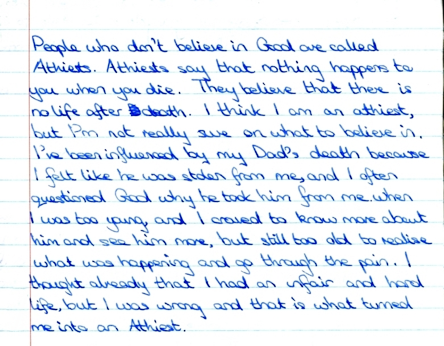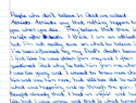Exemplification for foundation subjects
Religious education exemplification standards file level 8
Pupil's profile
Pupil F is a self-motivated learner keen to understand different religious practices. He is interested in how religious education connects to his life and often engages philosophically with what he is learning, particularly during lively discussions. He is good at synthesising materials and bringing together his ideas into coherent pieces of work.
Evidence groups
What can be learnt at the Imperial War Museum?
Context
After a visit to the Imperial War Museum to study the persecution of Jewish people under Nazism, Pupil F chose five items from the collection that moved him and gave the reasons why. The aim of the activity was to encourage him to analyse and interpret forms of expressions. The activity linked to work in history.
Pupil's work
Extract from Holocaust assessment
This is an extract from Pupil F's analysis of the five artefacts he selected.
Next steps
To progress, Pupil F needs to:
explore theological or philosophical responses, for example consider the theological impact of the Shoah on some Jewish people by responding to Franklin Sherman's statement that 'belief in the Almighty's love and care is much more difficult after Auschwitz, if not impossible.'
How does meditation lead to calmness for Buddhists and me?
Context
The class was visited by a Buddhist who explained the practice of meditation before leading a session for pupils. After the visit, pupils reflected on the experience and considered what impact Buddhist meditation might have on their lives and lives of others.
Pupil's work
Reflection on Buddhist meditation
Assessment commentary
In this piece of writing, Pupil F shows he can relate concepts drawn from Buddhism to the shared human experience of deciding how to spend time. He includes ideas related to attachment, suffering, satisfaction and happiness.
Enquiring, investigating and interpreting:
Pupil F has connected the practice of meditation and right mindfulness with other Buddhist practices (such as Right Action, from the Eightfold Path) when he says 'some Buddhists would choose not to meditate...'. This comment also shows he understands there are differences within religions.
With his comment 'If I meditated though it might help me to remember other people…' he suggests that while meditation can be useful, sometimes action will be better but he also adds to this thought that perhaps one might sustain the other.
Reflecting, evaluating and communicating:
Pupil F has synthesised a range of evidence, arguments and reflections to draw a balanced conclusion about the benefits of meditative practice. A strength of the work is that he holds together insights into Buddhism, including ideas from the Noble Truths and the Eightfold Path and the reduction of suffering, with more personal reflections on his own life.
The comment he made about stories ('some stories are not important because they happened, but because they teach us something which is true') is further evidence that he can synthesise reflections to help him justify his own perspective.
Next steps
To progress, Pupil F needs to:
understand more precisely Buddhist meditative practice, for example that it does not aim directly to address 'Western modern' concepts of stress, relaxation, satisfaction and happiness.
Theravada and Mahayanan Buddhists: What are their teachings about life after death?
Context
Pupil F investigated why Buddhists from different schools of the tradition have varied understandings of the detailed teachings about nirvana and release from the cycle of rebirth.
Pupil's work
Diversity within Buddhism
This is an extract from a long essay comparing Theravada and Mahayanan Buddhists.
Assessment commentary
Pupil F has handled the complexities of the Buddhist tradition with dexterity and clarity. He has explained religious beliefs, used sources and evaluated how religious beliefs and teaching inform answers to ultimate questions. He has referred to history and culture to set his ideas about Buddhism in context.
Thinking about religion and belief:
Pupil F has compared similarities in beliefs and teachings and given reasons for differences in religious practices, for example he gives cultural reasons such as 'Mahayanan Buddhism has spread far across the world which would have picked up beliefs and ideas that may not have anything to do with the Buddha'; 'some of the deities found in temples in Tibet are from the old religion of Tibet before Buddhism arrived' and 'the colourfulness of Tibetan Buddhism is more to do with the people than with the Buddhism'.
He has analysed different interpretations of the ultimate question of life after death from within the different schools of Buddhist tradition, referring to sources for Buddhist teaching/dhamma as well as the influence of history and culture ('Theravada Buddhists only pay attention to the older (texts), as it is the oldest school and they don't believe the later ones...'). He has explained the different interpretations in the light of this wide understanding of the texts and sources for Buddhist teaching/dhamma.
Next steps
To progress, Pupil F needs to:
discuss authentic Buddhist texts with Buddhist practitioners from different schools of the tradition
refine his use of material from different schools of thought and use quotations from sacred texts to bring balance and clarity to his arguments.
What are the differences between liberal and evangelical Christian beliefs about life and death?
Context
In this piece of work, pupils explored different viewpoints from within the Christian community on a number of ultimate questions, including questions about destiny and the purpose of life. Rather than teaching pupils about denominational differences in Christianity, this school presented ideas within Christianity as 'liberal' or 'evangelical'. Pupils were encouraged to use concepts of biblical authority and biblical exegesis to evaluate different forms of religious expression.
Pupil's work
_medium_tcm8-17465.jpg)
Diverse Christian beliefs about life after death (cont.)
Talking about life after death
Assessment commentary
Pupil F again shows his ability to bring together many ideas and concepts into a coherent piece of analysis.
Thinking about religion and belief:
Pupil F has analysed different viewpoints within the Christian religion. He shows he understands that Christianity takes many forms and while not accurate on every point, has grasped the essentials of liberal and evangelical views on life after death and destiny. His descriptions of the perspectives are always questioning. He has used concepts like judgement day, invisible soul, heaven, hell paradise, the good life, belief in God and Jesus with confidence.
Enquiring, investigating and interpreting:
Pupil F has used his understanding of the diversity of Christianity to interpret biblical texts in different ways. Where he writes about the difference between belief in judgement day and belief in the everlasting soul he shows an awareness of the impact of both beliefs.
His references to the biblical narrative of the resurrection of Jesus show he can use his interpretations of Christian sacred text as part of his analysis. He uses a wide range of terminology and concepts to bring together his broad understanding of belief about life after death. Using his own initiative he has connected what he learnt previously on Buddhist teaching about samsara and nirvana with Christian beliefs about the after life.
In his evaluations, he has used sources from sacred text, and given coherent interpretations of the religious materials studied in relation to ultimate questions of purpose and truth. He has used some of the main methods by which religion is studied - textual criticism, comparison, weighing up a range of interpretations - to analyse beliefs about life after death.
Next steps
To progress, Pupil F needs to:
develop philosophical arguments that express his own critical evaluations of Buddhist and Christian beliefs
justify his ideas using a range of arguments and evidence in relation to religious and non-religious beliefs about life after death.
Life after death: which way do the arguments point?
Context
This is the opening page of a longer piece of work in which Pupil F explored and deepened his understanding of Buddhist dhamma/teaching. The activity aimed to bring together his understanding of Buddhist teaching.
Pupil's work
Essay on life after death
This is an extract from a longer piece.
Assessment commentary
In this piece of work, Pupil F has analysed Buddhist teaching about questions of meaning and purpose in life. He has made connections between key concepts (samsara, nirvana, moksha and dharma) and synthesised his understanding of the teachings.
Thinking about religion and belief:
Pupil F has brought together ideas from Buddhist teaching and ethics into a complex description. In explaining and handling concepts of 'no-self', dukkha, dharma, nirvana, samsara and rebirth distinguished from re-incarnation, Pupil F has used a range of concepts in his analysis of Buddhist ideas. He shows breadth of learning in his use of definitions ('the end of suffering'), distinctions ('it is not actually you reborn because...') and comparisons ('similar to heaven because...').
In handling the questions of meaning and purpose that are associated with ideas about life after death, Pupil F has offered a broad and deep understanding of Buddhist ideas and provided a detailed analysis of how sources of the teaching are interpreted and applied.
Next steps
To progress, Pupil F needs to:
widen his understanding of the application of religious teaching and sources, for example by relating Buddhist teaching to ethical issues.
What leads some people to atheism?
Context
In this piece of work, Pupil F expresses his own sense of grief at a huge personal loss. It shows how religious education can help pupils engage with the deepest questions of life. It also shows how religious education often prompts disclosures and personal thoughts from pupils.
Pupil's work

Personal reasons for atheism
Pupil F expresses deep emotion and remarkably clear thought in this moving piece of writing. This kind of writing shows the profound dialogue between teacher and learner that can result from religious education.
Assessment commentary
This work is a powerful example of the way 'learning from religion and belief' provides pupils with an opportunity to grapple with the fundamental questions of life and spirituality.
Reflecting, evaluating and communicating:
Pupil F uses powerful language in this piece of reflective writing ('stolen from me...', 'craved to know...'). The writing clearly shows the impact of his father's death on his own perspective. It also shows Pupil F's ability to persuasively report his own justified thoughts.
Teachers encountering this kind of response to the questions posed in religious education should, of course, respond to pupils individually and offer professional and pastoral support.
Pupil F might benefit from exploring how, for some people, tragedy leads to a different or deeper belief in God. However, this would be best taught in a way that would allow him to distance himself from his own experiences.
Next steps
It is not appropriate to give next steps for this piece of work.
What have I learnt from RE this year?
Context
As part of gifted and talented provision at the school, Pupil F took part in a discussion about the year's work. These edited extracts show some of the contributions he made in a discussion that lasted nearly an hour.
Pupil's work
Reflections on a year of work
Assessment commentary
Pupil F covers a wide range of topics in this conversation. His comments show his ability to synthesise his learning and draw personal and critical conclusions from his work.
Reflecting, evaluating and communicating:
Although tentative, Pupil F expressed personal viewpoints about the topics he studied. He shows he engaged with the moral atrocities of the Holocaust and the associated racism and with the spiritual issues relating to life after death. He has interpreted for himself a wide range of views and arguments about topics such as science and religion, atheism and religious ways of living.
Next steps
To progress, Pupil F needs to:
devise his own enquiries into religious pluralism in the UK and attitudes to religious and secular views
engage more systematically with arguments relating to the philosophy of religion or psychology of religion.
Overall assessment judgement
Religious education exemplification standards level 8
Overall, Pupil F is working at level 8.
Thinking about religion and belief:
Pupil F has used a wide range of religious and conceptual vocabulary to analyse questions about Buddhist practice and meditation, teaching about life after death and the purposes of life. His analysis of different interpretations and answers to ultimate questions from both within and between Christianity and Buddhism shows he is alert to the different contexts of religion through time.
Enquiring, investigating and interpreting:
Pupil F has researched independently the significance of objects associated with the Jewish shoah, making critical enquiries of his own into connections between race and religion. In his extended enquiry into questions about life after death, he showed he could use his wide understanding of religion and belief to interpret a variety of forms of religion.
Reflecting, evaluating and communicating:
Pupil F has synthesised ideas and teachings from different schools within religions. He has responded to challenging ideas with both detachment and a very personal engagement. He has justified his conclusions and accounted for the views of others.
The extracts of pupil work below are a reminder of some of the evidence used to make these judgements.

_thumb_tcm8-16997.jpg)
_thumb_tcm8-16998.jpg)

_medium_tcm8-17464.jpg)

Assessment commentary
In his essay, Pupil F has explored the interplay between religion, history and politics to analyse the reasons for the rise of prejudice and hatred of Jewish people. This extract shows his analysis of how Nazi fascist ideology was communicated through a children's book.
Thinking about religion and belief:
Pupil F has considered the historical, social and cultural contexts of the material he studied.
Enquiring, investigating and interpreting:
He has used what he learnt in history and religious education to analyse the objects he selected. This extract shows he independently researched arguments about the causes of racism in the context of the Shoah and drew conclusions from the material.
He has considered how moral ideas are formed through propaganda and contrasted this with the themes in Harry Potter books. He has interpreted varied forms of moral understanding, for example when he writes 'The book could be just a historical item to show how some books could be so cruel and to make people realise how wrong it was so books like that are not published again. In our children's books it teaches us good things…'.
Reflecting, evaluating and communicating:
When Pupil F talks about the role of the Nazi book in changing the views of the children who read it, he shows he understands how moral views and a sense of obligation can come from beliefs and experience. He has discussed a range of sources as evidence of the 'morality' of the Nazis and addressed the impact of the sources on events. When he writes 'Our society has changed in the light of the Shoah because it is illegal to write books that are racist' he shows his understanding of the impact of the Holocaust on contemporary ethics and attitudes.